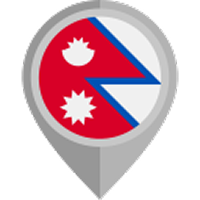Nepal vision | 27/03/2025
Every trekker dreams of walking through rugged trails and breathtaking landscapes, surrounded by Nepal’s towering peaks. But along with the beauty of these high-altitude regions comes a common challenge—altitude sickness.
Altitude sickness is a condition in which the body struggles to get enough oxygen, causing headaches, dizziness, and fatigue. As you climb higher, the oxygen level in the air drops, making it harder for your body to function correctly.
Nepal, the ultimate trekking paradise and home to the world’s tallest peaks, sees altitude sickness frequently among adventurers. While it’s familiar, it can turn serious if not managed well. That’s why understanding altitude sickness is essential for every trekker aiming to explore Nepal’s highlands safely.
The Himalayan Highs and Lows: What is Altitude Sickness?
Altitude sickness or acute mountain sickness is a condition that arises when you struggle to adjust to a lower oxygen level at altitudes above 2500m. As you climb higher, the air level reduces, which signifies a lower oxygen level, making it harder for your body to function properly. Headache, dizziness, vomiting, shortness of breath, nausea, and fatigue are the signs indicating that your body has not adapted to the altitude. If these symptoms become severe, they can cause high-altitude pulmonary edema (HAPE) or high-altitude cerebral edema (HACE), which requires immediate medical attention.
In Nepal’s trekking regions, altitude sickness is a serious concern. Studies show it accounts for about 10–13% of trekking-related deaths and has an incidence rate of around 30% in the Everest region. At 4,559 meters, the risk of severe altitude sickness can be as high as 6% with rapid ascent.
Many trekkers underestimate it, but if ignored, altitude sickness can turn an exciting adventure into a dangerous situation. The good news? It’s preventable!
Before the prevention measure, we need to take time to understand its causes and symptoms to help you get to know more about this condition.
What Causes Altitude Sickness? The Science Behind the Suffering
The lower level of oxygen is the most common cause of altitude sickness. Your body struggles to function, and that’s where altitude sickness steps in. The lack of oxygen messes with your body’s normal processes. But, this might not be the only cause, as some things can ignite the causes of altitude sickness.
Going Up Too Fast
Climbing too quickly is one of the quickest ways to make your body freak out. Try to picture running a race without warming up first; your body is in no shape to handle the stress. Similarly, if you rush up to high altitudes without giving your body time to adjust, you’re asking for trouble. Slow and steady is the name of the game when trekking in the Himalayas.

Nature’s Game
The weather in the mountains can change on a dime, and it can make things worse for your body. Add to that dehydration and your overall fitness level, and you’ve got a recipe for altitude sickness. If you’re dehydrated or out of shape, your body will have an even harder time adjusting to the thin air. Mother Nature and your health are key players in this high-altitude experience.
The Symptoms Of Altitude Sickness
The common and early signs are headaches, nausea, and all-too-familiar fatigue. If you’re feeling off, it’s your body’s way of telling you that something’s not right.
However, moderate symptoms might include Difficulty sleeping, dizziness, and loss of appetite. In severe cases, swelling, confusion, and difficulty walking may also occur.
Altitude sickness is quite manageable in the initial times, but in severe conditions, you might be late if you do not take any action under the medical professional.
HAPE (High Altitude Pulmonary Edema)
- Symptoms: Shortness of breath, persistent dry cough, severe fatigue, and in severe cases, pink frothy sputum.
HACE (High Altitude Cerebral Edema)
- Symptoms: Severe headache, confusion, loss of coordination, and visual disturbances.
Altitude Sickness Prevention
The initial manageable prevention methods are well-known among seasoned trekkers, but for many, they may still seem unfamiliar. So, let’s get right into it. Here’s how you can stay ahead of altitude sickness with simple yet effective strategies.
Slow and Steady Wins the Race
Your body needs time to adjust to thinner air. Ascending slowly and taking rest days allow your body to acclimatize to higher altitudes to reduce the risk of altitude sickness.
The Power of Acclimatization
A key principle for avoiding AMS is the "climb high, sleep low" strategy. Spend your days at higher elevations, but return to a lower altitude to sleep.
Diamox and You
Diamox (acetazolamide) is commonly used to help prevent altitude sickness by promoting acclimatization. While it can help, it's not a substitute for gradual ascent and proper rest. Always consult a doctor before using it, as it might not be suitable for everyone.
Drink, Eat, Repeat
Enough water is the key to keeping your energy high in those altitudes, as dehydration can fuel altitude sickness. Drink plenty of water and ensure you're getting nutritious meals to keep your energy levels high.
Gear Up for Success
Wearing the right clothing and bringing appropriate gear, such as proper footwear and layers, can help your body function more efficiently
No Booze, No Smoking
Alcohol and smoking can impair the ability of your body to adapt to higher altitudes. They also dehydrate you, further increasing your risk of altitude sickness. Stick to healthy habits, and keep drinks and cigarettes at sea level.
Severe Cases: The Emergency Game Plan
When altitude sickness turns serious, acting fast can save lives. Here’s what you need to know:
- Don't Panic—Just Descend: If symptoms of HAPE or HACE appear, immediate descent to a lower altitude is crucial. The faster, the better.
- Evacuation 101: In extreme cases, helicopter rescues and emergency evacuation services are available in Nepal’s trekking regions. Make sure your travel insurance covers high-altitude evacuations.
- Guides to the Rescue: Experienced trekking guides, like those from Nepal Visio Trek, are trained in first aid and know how to spot danger signs early. Trust their expertise and follow their advice.

Acclimatization Tips for Popular Treks in Nepal
Staying safe at high altitudes is all about giving your body time to adjust. Here’s how to acclimatize correctly on some of Nepal’s most popular treks:
- Everest Base Camp Trek: Take rest days in Namche Bazaar (3,440m) and Dingboche (4,410m) to let your body adjust before climbing Everest Base Camp.
- Annapurna Circuit Trek: To avoid altitude sickness, spend extra time in Manang (3,519m) and Thorong Phedi (4,540m) before crossing Thorong La Pass (5,416m).
- Manaslu Circuit Trek: Acclimatization stops in Samagaun (3,520m) and Samdo (3,875m) help prepare you for the Larke Pass (5,106m).
- Kanchenjunga Base Camp Trek: Since this trek reaches 5,143m, plan rest days in Ghunsa (3,475m) and Lhonak (4,780m) to avoid altitude sickness in this remote region.
To wrap up, Trekking in Nepal is a fantastic experience, but altitude sickness can make it tough if you’re not careful. The best way to stay safe is to climb slowly, take rest days, drink plenty of water, and listen to your body. If you start feeling sick, don’t ignore it; take action and descend if needed.
Want a safe and well-planned trek? Nepal Vision Treks has expert guides trained to help you handle altitude sickness and keep your journey smooth.
FAQS









